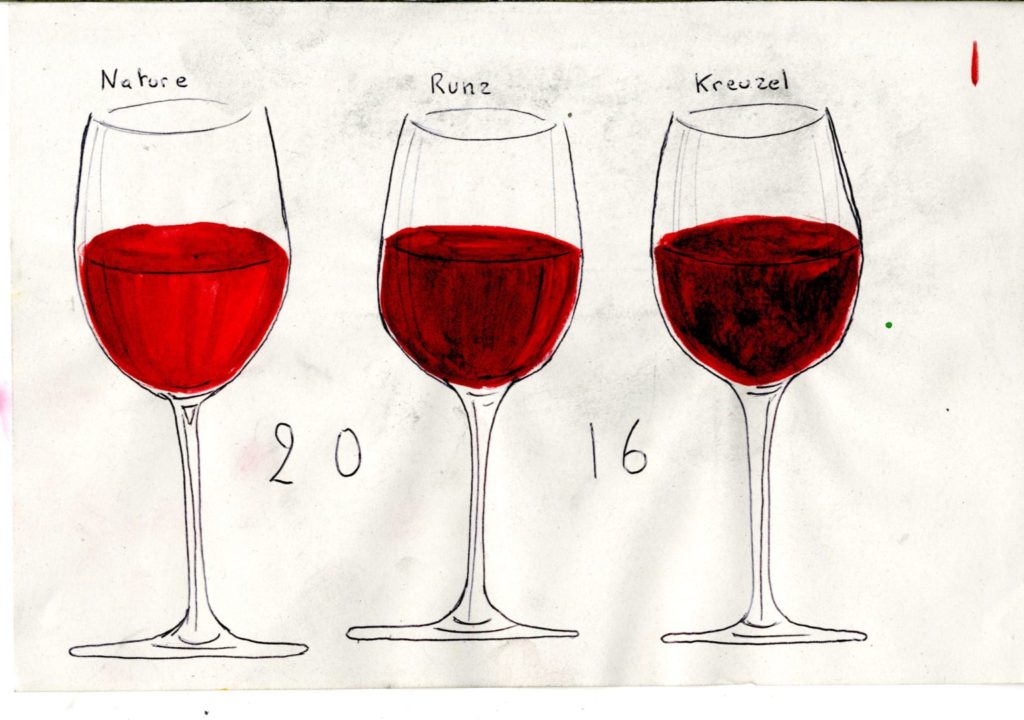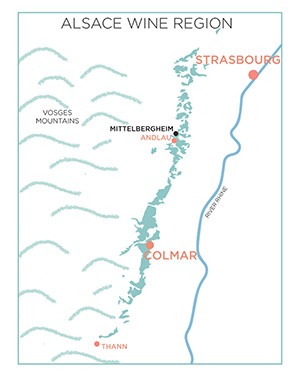Lucas Rieffel
The Location
DATE OF DOMAIN REVIEW – August 2017
Update required, but domain management and approach, very much still in line with this write up.
Lucas Rieffel’s winery is in the village of Mittelbergheim. A place that feels like it’s close to somewhere else, like Heaven’s Door. Somewhere special, where something special is happening. That something is a group of winemakers that has developed a loose collective approach to modern Alsace wine making. The group includes Lucas Rieffel, Jean-Pierre Rietsch, Catherine Riss, André Kleinknecht, Ludo Rohrer and Antoine Kreydenweiss from nearby Andlau. The individuals come with different experience, influences and reputations, but have somehow developed a fresh way forward. Associated with the group are several local and not-so-local artists that are involved in designing graphics around the different wines. We call it The Mittelbergheim School.
Mittelbergheim is in the Bas Rhin (the Lower Rhine) department in Alsace. It is approximately 25 km south, southwest of Strasbourg and is a “wine village” with around 650 inhabitants and 20+ winemakers. A string of Grand Crus is close by and also a bundle of lieux-dits (place names) vineyards. These are historically demarcated and have reputations. Several of these lieux-dits are included in the project to recognise a Premier Cru hierarchy in Alsace.
The Grand Crus we will mention here are the Kirchberg de Barr which lies a couple of kilometres north of Mittelbergheim, the Zotzenberg that hugs the west side of the village, the Wiebelsberg which runs along the hills to the south and its neighbour, the Kastelberg, that sits dominating Andlau.
The Winemaker
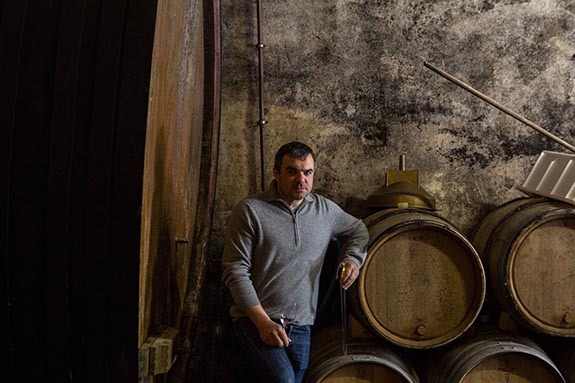 Multiple generations of the Rieffel family have lived in Mittelbergheim and the family house and buildings date to the 15th century. Lucas is the third generation in terms of bottling and commercialising wine and has been fulltime on the domaine since 1996.
Multiple generations of the Rieffel family have lived in Mittelbergheim and the family house and buildings date to the 15th century. Lucas is the third generation in terms of bottling and commercialising wine and has been fulltime on the domaine since 1996.
Some of his key influences come from André Ostertag and Patrick Meyer, in the nearby villages of Epfig and Nothalten. André can be considered as the father of the new wave (père de la nouvelle vague) that brought in the acceptance of the use of barriques for white wine in Alsace amongst other changes. Patrick is one of the renowned/infamous/famous/mythical/real “Gang of Four” (Les Quatre Mousquetaires).
This group helped to set up and consolidate the natural wine (vins nature) movement in Alsace, with its focus on expression of terroir through organic farming and minimal friggin around with the resulting pressed grape juice. Lucas’s influences are now extended to his local contemporaries and also a wider network of well thought-out producers, like Julien Guillot from Mâcon and Fabien Jouves from Cahors.
The Vineyards and the Wines
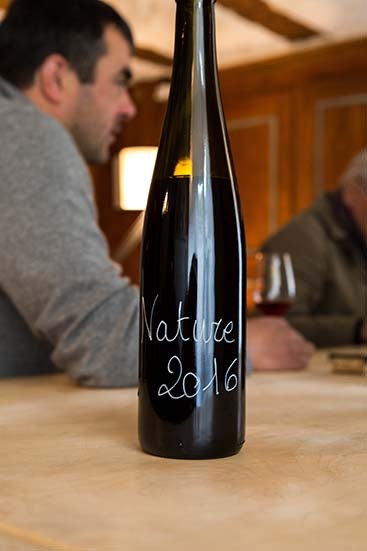 Annual production is currently around 60,000 bottles, which is made up of 10 to 14 different cuveés depending on the year. 50% of the production is exported, mostly to Japan, the USA, the UK, Belgium and Norway. You can drink Lucas Rieffel wines in my hometown Edinburgh and in San Francisco, my current home base.
Annual production is currently around 60,000 bottles, which is made up of 10 to 14 different cuveés depending on the year. 50% of the production is exported, mostly to Japan, the USA, the UK, Belgium and Norway. You can drink Lucas Rieffel wines in my hometown Edinburgh and in San Francisco, my current home base.
Here is Brett Pallesen who runs the California based import company Soil Expedition “ Lucas Rieffel’s wines are extremely transparent in relation to their terroir. He’s worked steadfastly since 1996 to move the family historic estate to a level of firm sustainability and overall identity. Through this time, Lucas has come into his own and it shines in his wines. He should be considered as one of the best young vignerons of this booming generation in probably, the most exciting region in France today.” Well, Back In Alsace is not going to disagree with that last statement.
The domaine has been fully certified for organic farming methods since the 2012 harvest, with the conversion starting back in the early 2000’s. Lucas explained that he is going through a replanting program, grubbing up and replacing between 20-50 ares per year. That takes these areas out of production for 5-7 years. The new vineyards are being planted at higher densities of between 6,000 and 7,000 plants per hectare, with some replanting on the Wiebelsberg Grand Cru at 8,000. These measures, coupled with controlled lower yields, have resulted in excellent primary fruit quality.
There is a speciality of grape variety with the various vineyards. On the Grand Cru vineyards, that speciality maps to Pinot Gris on the Kirchberg de Barr, Sylvaner and Riesling on the Zotzenberg and Riesling on the Wiebelsberg. On the five main lieux-dits, it is Pinot Noir on the Runz, Pinot Blanc on the Gebreit, Riesling on the Brandluft, Pinot Gris on the Hagel and Gewurztraminer on the Gesetz. This gives a strong aspect of linking the variety, to the soil type and mesoclimate of each of these vineyards.
The cellar work is based on natural yeast fermentation, long press cycles of the harvested fruit, and a varied approach on whether cuveés are filtered or not. There is also a careful approach on the use of sulphur, from zero to small doses, again depending on cuveés, grape variety and the quality development of the wine. During the last ten years, there has been a gradual shift to longer development time on the lees for the domaine signature wines, both in the large foudres and in barriques.
We had the benefit and privilege of several conversations during five visits, with Lucas and the assistant wine maker (multitasker) Emilie Cousin. On one visit, tasting through the range of wines, we also had the privilege of being accompanied (kept on our toes) by Catherine Riss.
 Cremants – sparkling wine is one of the specialities of the domaine. During the visits we tasted the 2011, 12, 13 and 15. These were either the entry extra-brut or the specialist L’Emprise in magnums. The first fermentation is in old barriques and the wine is left to develop in the bottle (sur lattes) for 12-36 months. A small percentage of Riesling can be used to provide balanced acidity, especially in hot years like the recent 2015. The extra brut is based on a 70/20/10, Auxerrois/Pinot Gris/Chardonnay. The 2012 was non-dosed and disgorged after two years on the lattes. This was a nicely balanced Cremant with great acidity and fruit. The 2013 and 2015 had good tart acidity, again with a touch of brioche and more fruit to the fore in the 2015. The 2011 L’Emprise was based on 50/50 Pinot Gris/Chardonnay, with the Pinot Gris coming from the Grand Cru Kirchberg de Barr. This again was non-dosed and developed 3 years in the bottle before it was disgorged. Tasting notes mentioned a touch of yeast, with a hint of toast and brioche, with complexity and good roundness in the mouth.
Cremants – sparkling wine is one of the specialities of the domaine. During the visits we tasted the 2011, 12, 13 and 15. These were either the entry extra-brut or the specialist L’Emprise in magnums. The first fermentation is in old barriques and the wine is left to develop in the bottle (sur lattes) for 12-36 months. A small percentage of Riesling can be used to provide balanced acidity, especially in hot years like the recent 2015. The extra brut is based on a 70/20/10, Auxerrois/Pinot Gris/Chardonnay. The 2012 was non-dosed and disgorged after two years on the lattes. This was a nicely balanced Cremant with great acidity and fruit. The 2013 and 2015 had good tart acidity, again with a touch of brioche and more fruit to the fore in the 2015. The 2011 L’Emprise was based on 50/50 Pinot Gris/Chardonnay, with the Pinot Gris coming from the Grand Cru Kirchberg de Barr. This again was non-dosed and developed 3 years in the bottle before it was disgorged. Tasting notes mentioned a touch of yeast, with a hint of toast and brioche, with complexity and good roundness in the mouth.
A trio of Pinot Noir’s – another speciality of the house is Pinot Noir. Three different cuveés are made each year, Nature, Runz and Kreuzel and we had the opportunity to taste a range through from 2012 to 2016. Lucas finds that Pinot Noir provides the best opportunity to go with a natural wine approach and has now produced a Pinot Noir “nature” during several years. The gradation in colour between the three wines is nicely shown in Mona Neilson’s illustration. The Pinot Noir Nature targets a gourmandise fruit, and high buvability. This cuvee comes from vines just below the village. Fermentation is in stainless steel vats, followed by 8 months in 3-5 year barriques and bottled before the following harvest. The Pinot Noir Runz vineyard is just below the Zotzenberg Grand Cru and is mostly made up of older vines. The Kreutzel cuveé comes from a parcelle planted in the Grand Cru Zotzenberg in 2005, at 7000 plants per hectare. Wine making is similar for both the Runz and the Kreuzel, with 2-3 weeks whole cluster maceration in stainless steel then a transfer to 3-5 year barriques for 12 months. Yields are kept low at around 35 hl/ha to provide good fruit concentration. Both have great structure with light tannins, with an emphasis on taste of crushed red fruit and griotte cherries. The Kreuzel has a definite extra roundness but still retains that lovely delicate and fine Pinot Noir balance between acidity, fruit and weight. A trio of different and delicious Pinot Noirs, that come from three different lieux-dits close to the village.
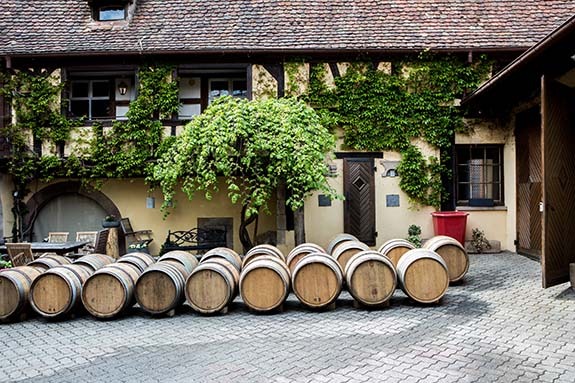 Pinot Blanc from the Gebriet lieux-dit – the Gebriet vineyard is on a sheltered granite plateau that sits over the top and behind the black slate of the Kastelberg Grand Cru. This little plateau is like a well-tended garden, with physically worked soils. Antoine Kreydenweiss also produces Pinot Blanc up on this plateau. Its height and exposure makes it a later ripening site and it is usually harvested 8-10 days after the Mittelbergheim vineyards. Auxerrois and Pinot Blanc are co-planted and two cuveés are made, one a natural wine labelled “Nu”, French for naked, from 35-40 year old vines, with around 800 bottles produced each year. The other is a more classic Pinot Blanc from 40-50 year old vines, with 2500-3000 bottles produced every year.
Pinot Blanc from the Gebriet lieux-dit – the Gebriet vineyard is on a sheltered granite plateau that sits over the top and behind the black slate of the Kastelberg Grand Cru. This little plateau is like a well-tended garden, with physically worked soils. Antoine Kreydenweiss also produces Pinot Blanc up on this plateau. Its height and exposure makes it a later ripening site and it is usually harvested 8-10 days after the Mittelbergheim vineyards. Auxerrois and Pinot Blanc are co-planted and two cuveés are made, one a natural wine labelled “Nu”, French for naked, from 35-40 year old vines, with around 800 bottles produced each year. The other is a more classic Pinot Blanc from 40-50 year old vines, with 2500-3000 bottles produced every year.
These are both serious Pinot Blanc’s raised in barriques. The natural ‘Nu’ cuveé has some reduction, a nice yellow taint, with tastes of white fruits, some salinity and a good finish. We tasted the 2013, 14, 15 and 16 and there is great consistency with a level of complexity and depth that makes this a top Alsace Pinot Blanc.
Riesling from the Wiebelsberg Grand Cru – the 12.5 hectares of the Wiebelsberg has a soil type of sand and sandstone and is super quick draining. The exposure is south southeast, with a medium gradient slope running from 200-300 meters. It sits like an angled block to take the sun full on. The Wiebelsberg can cool quickly in the evening as shadows are taken on from the adjacent Kastelberg hill and from the forest running along the top and west side of the vineyard. The Wiebelsberg has a reputation for pure and elegant structured Rieslings, resulting from the soil type and exposure. The reputation includes long cellar potential. The 2014 had a touch of colour, a complex taste of citrus fruits and dried apple skin, which are tied into a vertical, mineral structure. The finish was long with a delicate salinity.
Pinot Gris from the Kirchberg de Barr Grand Cru – 40.6 hectares with a soil type of marl and limestone, facing directly southeast. The Pinot Gris parcelles are approximately 0.5 hectares from the area of the Grand Cru named La Colline des Escargots, the hill of the snails. The Kirchberg is an early ripening site that lends itself to Pinot Gris. The 2015 had a clear amber colour, delicate ripe fruit on the nose and the taste was fully round with gingerbread and more cooked fruits. A good level of acidity keeps the ripe fruits in balance.
 Sylvaner from the Zotzenberg Grand Cru – the Zotzenberg is the only Grand Cru to allow Sylvaner as a classified noble variety and Mittelbergheim has a long lasting tradition for first class Sylvaner. We will follow up in some detail on Sylvaner at a later date, as it’s an Alsace variety that is increasingly found in the export markets. The reputation of Sylvaner has significantly grown in the last 10 years. Much of that is due to the total surface planted being significantly reduced, allowing the top winemakers to set a well-recognised high standard. In 1970, Sylvaner was the most common variety in Alsace with 27% of the total vineyard area. In 2016 the area planted was down to 6%.
Sylvaner from the Zotzenberg Grand Cru – the Zotzenberg is the only Grand Cru to allow Sylvaner as a classified noble variety and Mittelbergheim has a long lasting tradition for first class Sylvaner. We will follow up in some detail on Sylvaner at a later date, as it’s an Alsace variety that is increasingly found in the export markets. The reputation of Sylvaner has significantly grown in the last 10 years. Much of that is due to the total surface planted being significantly reduced, allowing the top winemakers to set a well-recognised high standard. In 1970, Sylvaner was the most common variety in Alsace with 27% of the total vineyard area. In 2016 the area planted was down to 6%.
The 36.4-hectare Zotzenberg vineyard has marl limestone soil and faces east south, with a gentle undulating incline. The recently tasted 2012 Sylvaner was clear with almost no colour and with pear skins and astringent fruit on the nose. The taste was full and complex, with orange fruits, mild marmalade and again a certain astringency. There was good salinity on the finish.
The 2013 was again super clear, more delicate on the nose with a touch of hay, the taste was more white fruits and quince. The wine was bone dry with a long finish with an aspect of minerality linked to the Zotzenberg site.
Lucas RIEFFEL
60,000 bottles
10 hectares
11, rue Principale
67140 MITTELBERGHEIM
+33 3 88 08 95 48
